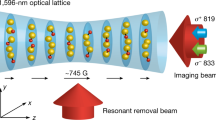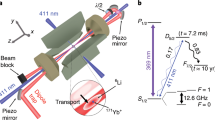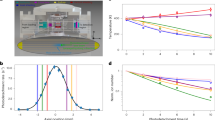Abstract
The preparation of cold molecules is of great importance in many contexts, such as fundamental physics investigations1,2, high-resolution spectroscopy of complex molecules3,4,5, cold chemistry6,7 and astrochemistry8. One versatile and widely applied method to cool molecules is helium buffer-gas cooling in either a supersonic beam expansion9,10 or a cryogenic trap environment11,12. Another more recent method applicable to trapped molecular ions relies on sympathetic translational cooling, through collisional interactions with co-trapped, laser-cooled atomic ions, into spatially ordered structures called Coulomb crystals, combined with laser-controlled internal-state preparation6,7,13,14,15,16,17,18,19,20,21,22,23. Here we present experimental results on helium buffer-gas cooling of the rotational degrees of freedom of MgH+ molecular ions, which have been trapped and sympathetically cooled13 in a cryogenic linear radio-frequency quadrupole trap. With helium collision rates of only about ten per second—that is, four to five orders of magnitude lower than in typical buffer-gas cooling settings—we have cooled a single molecular ion to a rotational temperature of  kelvin, the lowest such temperature so far measured. In addition, by varying the shape of, or the number of atomic and molecular ions in, larger Coulomb crystals, or both, we have tuned the effective rotational temperature from about 7 kelvin to about 60 kelvin by changing the translational micromotion energy of the ions24. The extremely low helium collision rate may allow for sympathetic sideband cooling of single molecular ions, and eventually make quantum-logic spectroscopy25 of buffer-gas-cooled molecular ions feasible. Furthermore, application of the present cooling scheme to complex molecular ions should enable single- or few-state manipulations of individual molecules of biological interest4,5.
kelvin, the lowest such temperature so far measured. In addition, by varying the shape of, or the number of atomic and molecular ions in, larger Coulomb crystals, or both, we have tuned the effective rotational temperature from about 7 kelvin to about 60 kelvin by changing the translational micromotion energy of the ions24. The extremely low helium collision rate may allow for sympathetic sideband cooling of single molecular ions, and eventually make quantum-logic spectroscopy25 of buffer-gas-cooled molecular ions feasible. Furthermore, application of the present cooling scheme to complex molecular ions should enable single- or few-state manipulations of individual molecules of biological interest4,5.
This is a preview of subscription content, access via your institution
Access options
Subscribe to this journal
Receive 51 print issues and online access
$199.00 per year
only $3.90 per issue
Buy this article
- Purchase on Springer Link
- Instant access to full article PDF
Prices may be subject to local taxes which are calculated during checkout




Similar content being viewed by others
References
Hudson, E. R., Lewandowski, H. J., Sawyer, B. C. & Ye, J. Cold molecule spectroscopy for constraining the evolution of the fine structure constant. Phys. Rev. Lett. 96, 143004 (2006)
Hudson, J. J. et al. Improved measurement of the shape of the electron. Nature 473, 493–496 (2011)
Kamrath, M. Z., Relph, R. A., Guasco, T. L., Leavitt, C. M. & Johnson, M. A. Vibrational predissociation spectroscopy of the H2-tagged mono- and dicarboxylate anions of dodecanedioic acid. Int. J. Mass Spectrom. 300, 91–98 (2011)
Rizzo, T. R., Park, Y. D., Peteanu, L. A. & Levy, D. H. The electronic spectrum of the amino acid tryptophan in the gas phase. J. Chem. Phys. 84, 2534–2541 (1986)
Stearns, J. A. et al. Conformation-specific spectroscopy and photodissociation of cold, protonated tyrosine and phenylalanine. J. Am. Chem. Soc. 129, 11814–11820 (2007)
Willitsch, S., Bell, M. T., Gingell, A. D. & Softley, T. P. Chemical applications of laser-and sympathetically-cooled ions in ion traps. Phys. Chem. Chem. Phys. 10, 7200–7210 (2008)
Carr, L. D., DeMille, D., Krems, R. V. & Ye, J. Cold and ultracold molecules: science, technology and applications. New J. Phys. 11, 055049 (2009)
Smith, I. W. M. Low Temperatures and Cold Molecules (Imperial College Press, 2008)
Hutzler, N. R. A cryogenic beam of refractory, chemically reactive molecules with expansion cooling. Phys. Chem. Chem. Phys. 13, 18976–18985 (2011)
Scoles, G., Bassi, D., Buck, U. & Laine, D. C. Atomic and Molecular Beam Methods Vol. 1 (Oxford Univ. Press, 1988)
Gerlich, D. Ion-neutral collisions in a 22-pole trap at very low energies. Phys. Scr. T59, 256–263 (1995)
Weinstein, J. D., deCarvalho, R., Guillet, T., Friedrich, B. & Doyle, J. M. Magnetic trapping of calcium monohydride molecules at millikelvin temperatures. Nature 395, 148–150 (1998)
Mølhave, K. & Drewsen, M. Formation of translationally cold MgH+ and MgD+ molecules in an ion trap. Phys. Rev. A 62, 011401(R) (2000)
Staanum, P. F., Høbjerre, K., Wester, R. & Drewsen, M. Probing isotope effects in chemical reactions using single ions. Phys. Rev. Lett. 100, 243003 (2008)
Højbjerre, K. et al. Consecutive photodissociation of a single complex molecular ion. Phys. Rev. A 77, 030702(R) (2008)
Zipkes, C., Palzer, S., Sias, C. & Köhl, M. A trapped single ion inside a Bose–Einstein condensate. Nature 464, 388–391 (2010)
Schmid, S., Härter, A. & Denschlag, J. H. Dynamics of a cold trapped ion in a Bose-Einstein condensate. Phys. Rev. Lett. 105, 133202 (2010)
Staanum, P. F., Højbjerre, K., Skyt, P. S., Hansen, A. K. & Drewsen, M. Rotational laser cooling of vibrationally and translationally cold molecular ions. Nature Phys. 6, 271–274 (2010)
Schneider, T., Roth, B., Duncker, H., Ernsting, I. & Schiller, S. All-optical preparation of molecular ions in the rovibrational ground state. Nature Phys. 6, 275–278 (2010)
Tong, X., Winney, A. H. & Willitsch, S. Sympathetic cooling of molecular ions in selected rotational and vibrational states produced by threshold photoionization. Phys. Rev. Lett. 105, 143001 (2010)
Ostendorf, A. et al. Sympathetic cooling of complex molecular ions to millikelvin temperatures. Phys. Rev. Lett. 97, 243005 (2006)
Hansen, A. K., Sørensen, M. A., Staanum, P. F. & Drewsen, M. Single-ion recycling reactions. Angew. Chem. Int. Ed. 51, 7960–7962 (2012)
Versolato, O. O. et al. Decay rate measurement of the first vibrationally excited state of MgH+ in a cryogenic Paul trap. Phys. Rev. Lett. 111, 053002 (2013)
Blümel, R., Kappler, C., Quint, W. & Walther, H. Chaos and order of laser-cooled ions in a Paul trap. Phys. Rev. A 40, 808–823 (1989)
Schmidt, P. O. et al. Spectroscopy using quantum logic. Science 309, 749–752 (2005)
Hlavenka, P. et al. Absolute photodetachment cross section measurements of the O- and OH- anion. J. Chem. Phys. 130, 061105 (2009)
Schwarz, M. et al. Cryogenic linear Paul trap for cold highly charged ion experiments. Rev. Sci. Instrum. 83, 083115 (2012)
Schlemmer, S., Kuhn, T., Lescop, E. & Gerlich, D. Laser excited N2+ in a 22-pole ion trap: experimental studies of rotational relaxation processes. Int. J. Mass Spectrom. 185–187, 589–602 (1999)
Engel, G. S. et al. Evidence for wavelike energy transfer through quantum coherence in photosynthetic systems. Nature 446, 782–786 (2007)
Rellergert, W. G. et al. Evidence for sympathetic vibrational cooling of translationally cold molecules. Nature 495, 490–494 (2013)
Vogelius, I. S., Madsen, L. B. & Drewsen, M. Probabilistic state preparation of a single molecular ion by projection measurement. J. Phys. B 39, S1259–S1265 (2006)
Acknowledgements
M.D. appreciates generous support through the Danish National Research Foundation Center for Quantum Optics – QUANTOP; The Danish Agency for Science, Technology and Innovation; the Carlsberg Foundation; the Lundbeck Foundation; and the European Commission under the Seventh Framework Programme FP7 GA 607491 COMIQ. O.O.V., M.S., L.K. and A.W. acknowledge funding from STSM travel grants from COST-Action IOTA. Finally, the MPIK mechanical workshops have been of crucial importance for the construction of the cryogenic trap.
Author information
Authors and Affiliations
Contributions
L.K., O.O.V., A.K.H., S.B.K. and A.G. contributed equally to the work by carrying out the experiments, taking part in the data analysis and writing the manuscript. M.S., A.W., J.U. and J.R.C.L.-U. contributed significantly by designing and constructing the cryogenically cooled trap. M.D. contributed to the trap design, had the idea for the experiment, devised the experimental protocol, led the data analysis and wrote most of the manuscript.
Corresponding author
Ethics declarations
Competing interests
The authors declare no competing financial interests.
Supplementary information
Supplementary Information
This file contains Supplementary Text. (PDF 409 kb)
Rights and permissions
About this article
Cite this article
Hansen, A., Versolato, O., Kłosowski, Ł. et al. Efficient rotational cooling of Coulomb-crystallized molecular ions by a helium buffer gas. Nature 508, 76–79 (2014). https://doi.org/10.1038/nature12996
Received:
Accepted:
Published:
Issue Date:
DOI: https://doi.org/10.1038/nature12996
This article is cited by
-
Multi-photon ionisation spectroscopy for rotational state preparation of \({{\bf{N}}}_{{\bf{2}}}^{{\boldsymbol{+}}}\)
Scientific Reports (2019)
-
Rotational spectroscopy of cold and trapped molecular ions in the Lamb–Dicke regime
Nature Physics (2018)
-
Preparation and coherent manipulation of pure quantum states of a single molecular ion
Nature (2017)
-
Non-destructive state detection for quantum logic spectroscopy of molecular ions
Nature (2016)
-
Blue-sky bifurcation of ion energies and the limits of neutral-gas sympathetic cooling of trapped ions
Nature Communications (2016)
Comments
By submitting a comment you agree to abide by our Terms and Community Guidelines. If you find something abusive or that does not comply with our terms or guidelines please flag it as inappropriate.



